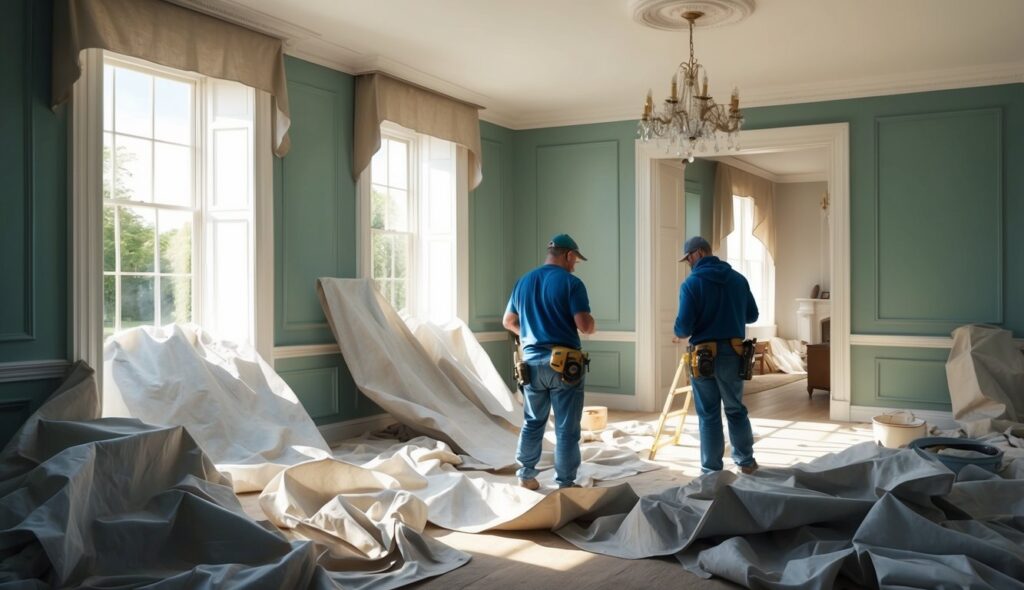How to Renovate a House: A Step-by-Step Guide and Where to Start
A Cautionary Note for Your Renovation!⚠️
Renovating a house can be thrilling yet daunting. Even though you’ve found a helpful guide, the renovation project may seem overwhelming. The complexity and sheer amount of planning required can easily make you anxious.
To ease your journey, consider breaking down the renovation process into manageable tasks. Joining a bite-size renovation email series could provide ongoing, digestible information, helping you stay focused without feeling swamped.
Whether it’s tackling unexpected electrical issues or uncovering hidden gems like old newspapers under carpets, each step has its challenges and surprises. By staying organised and prepared, you can navigate these hurdles more effectively, ensuring your home improvement efforts are successful and less stressful.
The point is to take it one step at a time and avoid getting bogged down by the entire project at once. Preparation and a well-structured renovation checklist can be your best allies.
From planning and budgeting to dealing with contractors and unforeseen complications, every aspect requires careful consideration. But remember, with a solid plan in place, any house renovation, whether small or large, can be executed successfully.
By collaborating with experienced professionals and utilising reliable resources, you can achieve the desired transformation for your home. From initial planning to the final touches, focus on each phase and don’t hesitate to seek guidance when needed. The right approach can turn what might initially seem like a daunting task into a smooth and rewarding renovation journey in the UK.
Renovating a House Step by Step – Where to Begin
Step 1: Identifying the Right Property for Renovation

If you’re in the market for a property to renovate, you might already have a few options lined up, or you might still be navigating through various listings. Initially, many newcomers to the renovation scene may not pinpoint a renovation project as their first choice. Similar to how some may have started their property search, you might also find yourself turning towards a renovation project, motivated either by a tight budget or the potential for personalised improvements.
When exploring property options, it is crucial to consider both the structure and innate potential of each property. The focus should be on properties with good structural integrity, spacious rooms, and possibilities for future expansions or conversions. Existing heating, electrics, and water installations are essential, especially if you plan to move in soon.
Key Considerations When Viewing Properties:
- Robust structural health – Look for properties with decent-sized rooms and the potential for future extensions.
- Essential utilities like heating, electrics, and water should be in place, especially if immediate occupancy is planned.
- Character features such as chimney breasts, alcoves, and stained glass windows can add value, though they are not always essential.
Experience has taught many homeowners the value of engaging professionals early on. Bringing an experienced contractor to viewings can provide insights into potential structural issues and renovation costs, aiding in budgeting and planning. Moreover, conducting a comprehensive building survey rather than a simple homebuyer report can reveal hidden issues, helping negotiate better purchase terms.
Professional Tips:
Hire an Experienced Contractor for Viewings:
- Identify potential structural issues.
- Get preliminary cost estimates.
- Assess feasibility of future plans, including planning approvals.
Conduct a Full Building Survey:
- Gain detailed insights into renovation needs and potential costs.
- Use survey findings to negotiate the purchase price.
Understand the Area’s Ceiling Price:
- Determine if the investment is suitable for potential resale or long-term living.
- Consider the locality and future resale value.
Exploring the feasibility of desired renovations is another critical aspect. Ensure potential modifications align with local regulations and structural possibilities by consulting with contractors or local planning offices. Investigating neighbouring properties for similar renovations can provide a benchmark for what is achievable within your chosen area.
Step 2: Securing Your Mortgage and Meticulous Budget Planning
Once you have secured a mortgage and your offer is accepted, the excitement begins. However, meticulous budget planning becomes paramount. Often, prospective renovators underestimate the costs involved, leading to unforeseen financial strain.
Budgeting should include a healthy contingency fund, ideally ranging from 10% to 20% of the total budget. Allocating funds for unforeseen expenses can prevent the project from stalling due to unexpected costs.
Budgeting Tips:
Set Aside a Contingency Fund:
- Allocate an additional 10-20% over your expected budget for unexpected expenses.
Phased Planning:
- Develop a phased renovation plan, prioritising essential works and spreading costs over time.
Often, the finishing touches, such as lighting, worktops, and furniture, can unexpectedly inflate the budget. Detailed planning and cost estimation for these items should be part of the initial budget to avoid running out of funds during critical final stages.
Cost Management:
- Maintain an updated list of anticipated expenses, covering all aspects from structural changes to interior finishes.
- Regularly review and adjust the budget as the project progresses to stay on track financially.
- Detailed budget items should include material costs, labour, tools, and essential services like electricity and plumbing.
Essential Guide: Lessons Learned from Renovation Experiences

Drawing from the experiences of past renovators, several key lessons and best practices emerge. These insights can inform and enhance your renovation strategy, paving the way for a more manageable and successful project.
Lessons from Experienced Renovators:
Engage with Professionals:
- From architects to project managers, professional guidance can prevent costly errors.
- Balance DIY efforts with professional input for complex tasks.
Prioritise Quality:
- Opt for quality materials and work to ensure durability and lessen future repair costs.
- Investing in quality upfront can reduce long-term maintenance expenses.
Effective Communication:
- Maintain open lines of communication with contractors and suppliers.
- Regular updates and clear expectations foster smoother cooperation and project flow.
Reflecting on common challenges can also highlight essential preemptive strategies. For example, many renovators underestimate the time and effort needed for regulatory approvals and essential utilities setup. Thorough initial planning can streamline these processes, reducing delays and unexpected hurdles.
Common Pitfalls and Solutions:
Regulatory Delays:
- Start approval processes early and maintain updated documentation.
Utility Setup Challenges:
- Factor in time and budget for essential utilities, potentially hiring specialists.
Practical Tips for Smooth Renovation Management
Embarking on a renovation project involves various practical aspects, from project management to material procurement. Comprehensive preparation and organised management are essential for staying on schedule and within budget.
Project Management Tips:
Create a Detailed Renovation Plan:
- Outline each phase of the project, including timelines and specific tasks.
- Integrate contingencies for potential delays or unexpected issues.
Hire a Project Manager:
- If managing the renovation alone is overwhelming, consider hiring a professional project manager.
- They can coordinate between different contractors and ensure adherence to timelines and budgets.
Procurement and Material Management:
Source Quality Materials:
- Research and compare suppliers to get quality materials at competitive prices.
- Purchase materials in bulk where possible to benefit from discounts.
Tool Management:
- Ensure you have all necessary tools before starting the project.
- Renting specialised tools can save costs if they are only needed for short periods.
Additional Considerations: Budgeting and Regulations
Navigating the financial and regulatory landscape is a critical component of any renovation project. Adhering to local regulations and maintaining a realistic budget can prevent legal issues and financial oversights.
Budgeting Strategies:
Detailed Financial Planning:
- Document all projected expenses, including a buffer for unforeseen costs.
- Regularly update the budget to reflect actual expenses and adjust as necessary.
Financing Options:
- Explore different financing options, such as renovation-specific loans or mortgages, to spread costs.
- Understand the terms and conditions of each financing option to choose the best fit for your financial situation.
Regulatory Compliance:
Understanding Local Regulations:
- Ensure your renovation plans comply with local building codes and regulations.
- Consult with local authorities or legal experts to clarify any regulatory requirements.
Permit Acquisition:
- Apply for necessary permits well in advance to avoid project delays.
- Keep track of permit status and ensure all inspections are scheduled and passed.
Armed with Experience: Practical Advice for Future Renovators
Drawing from practical experiences, future renovators can gain valuable insights to streamline their projects.
Comprehensive planning and practical strategies can make the renovation process more efficient and less stressful.
Top Tips from Experienced Renovators:
Thorough Initial Planning:
- Spend ample time planning each phase of the renovation to minimise surprises.
- Consult with industry professionals to refine and validate your plans.
Prioritise Projects:
- Focus on essential repairs and projects first to ensure structural integrity and habitability.
- Gradually tackle aesthetic improvements as the budget allows.
Flexibility and Adaptability:
- Be prepared to adapt plans based on new discoveries or unforeseen issues.
- Maintain a flexible timeline to accommodate any necessary changes.
Final Thoughts on Renovation:
Project Feasibility:
- Regularly assess the feasibility of planned renovations, consulting with professionals as needed.
Engaging with the Community:
- Tap into local networks or community groups for additional support and advice.
- Local recommendations can often lead to trustworthy contractors and suppliers.
By incorporating seasoned advice and practical strategies, future renovators can navigate their projects with confidence and minimise common pitfalls.
Comprehensive preparation, realistic budgeting, and flexible planning are key to successful and fulfilling home renovation experiences.
Want to Start Planning the Perfect House?

Step 5: Select and Engage Contractors for Quotes, Agree Costs, Set Dates, and Await Approvals
This is often a challenging phase, as securing the right team and getting the necessary approvals can be time-consuming.
It’s essential to be absolutely clear about your project requirements to avoid miscommunications and delays.
Tips:
Make the Project AppealingContractors receive numerous requests and might prioritise jobs that seem interesting and rewarding. Clearly outline why your project stands out and how it’s exciting.
- Comparison of Quotes
Make sure to obtain and compare multiple quotes fairly. Use a detailed checklist to ensure all quotes cover the same aspects. This will help you in making an informed decision on which contractor to hire.
Contracts and InsuranceIt’s crucial to have proper contracts in place before beginning any renovation work. Ensure that all parties are clear on their responsibilities and that insurance coverages are adequate.
Stay ProductiveUse the waiting period for product sourcing and decision-making. Start looking for tiles, taps, worktops, and other essentials. This proactive approach will save time and reduce stress later on.
What We Wish We Knew About Renovating Before We Started
Renovating a house is filled with potential pitfalls and learning curves. It is crucial to be prepared and aware of common challenges to mitigate risks and reduce stress.
Consider the Following:
Cost ManagementMaintaining a strict budget and keeping track of expenditures from the start can prevent costs from spiralling out of control.
Reliable ContractorsFinding trustworthy and reliable contractors can be difficult. One must do thorough background checks and seek recommendations from friends or family.
Planning and PermitsHaving detailed plans and understanding permit requirements well in advance can facilitate a smoother renovation process.
CommunicationClear and consistent communication with contractors and other parties involved is vital to avoid misunderstandings and delays.
Other Posts You May Like
Here are some additional topics that might interest you during your renovation journey:
- Inspiring Ideas for Interior Design
- Comprehensive House Renovation Checklist
- Insights on Structuring Your Home Renovation Project
- Ultimate Guide to Starting Your House Renovation
- Room-by-Room Renovation Order
Using these tips and insights can help you navigate your renovation project with confidence and clarity.
Frequently Asked Questions
Initiating a House Renovation in the UK
Starting a house renovation requires careful planning. One should first assess the current condition of the property.
This involves identifying any structural issues, determining whether the property is watertight, and planning the overall layout changes needed. Only once these steps are completed should one begin working on specific rooms.
Typical Sequence of House Refurbishment Work
The refurbishment process generally follows a systematic approach:
- Planning: Create a detailed plan outlining all intended changes.
- Structural Repairs: Address any structural issues such as roofing, foundation, and walls.
- Electrical and Plumbing: Update electricity and plumbing systems to meet current standards.
- Insulation and Drywall: Install insulation and put up drywall.
- Interior Finishes: Apply paint, install flooring, and add fixtures and fittings.
Suggested Checklist for Whole House Renovation
A well-thought-out checklist can ensure that you stay on track. Key tasks include:
- Initial Planning: Define the project scope, set a budget, and hire a team.
- Structural Integrity: Check and fix any foundational or structural problems.
- Waterproofing: Ensure the property is watertight.
- Electrical and Plumbing: Update or replace outdated systems.
- Interior Design: Plan for flooring, walls, and ceiling aesthetics.
- Final Touches: Add final fixtures and furniture.
Managing a House Renovation with No Experience
For those with no prior experience, it is important to:
- Consult Professionals: Seek advice from architects and builders.
- Research: Educate oneself on various aspects of renovation.
- Hire a Project Manager: Consider hiring someone experienced to oversee the renovation.
- Follow a Timeline: Stick to a clear, realistic timeline to manage progress effectively.
Approaching House Renovations Economically
Cost-effective renovation is possible by:
- Setting a Clear Budget: Allocate funds for each phase of the project.
- DIY Where Possible: Handle simple tasks yourself to reduce labour costs.
- Reusing Materials: Recycle or repurpose existing materials.
- Prioritising Projects: Focus on essential fixes first, delaying less urgent tasks.
- Seeking Multiple Quotes: Get several quotes for each project element to find the best price.

